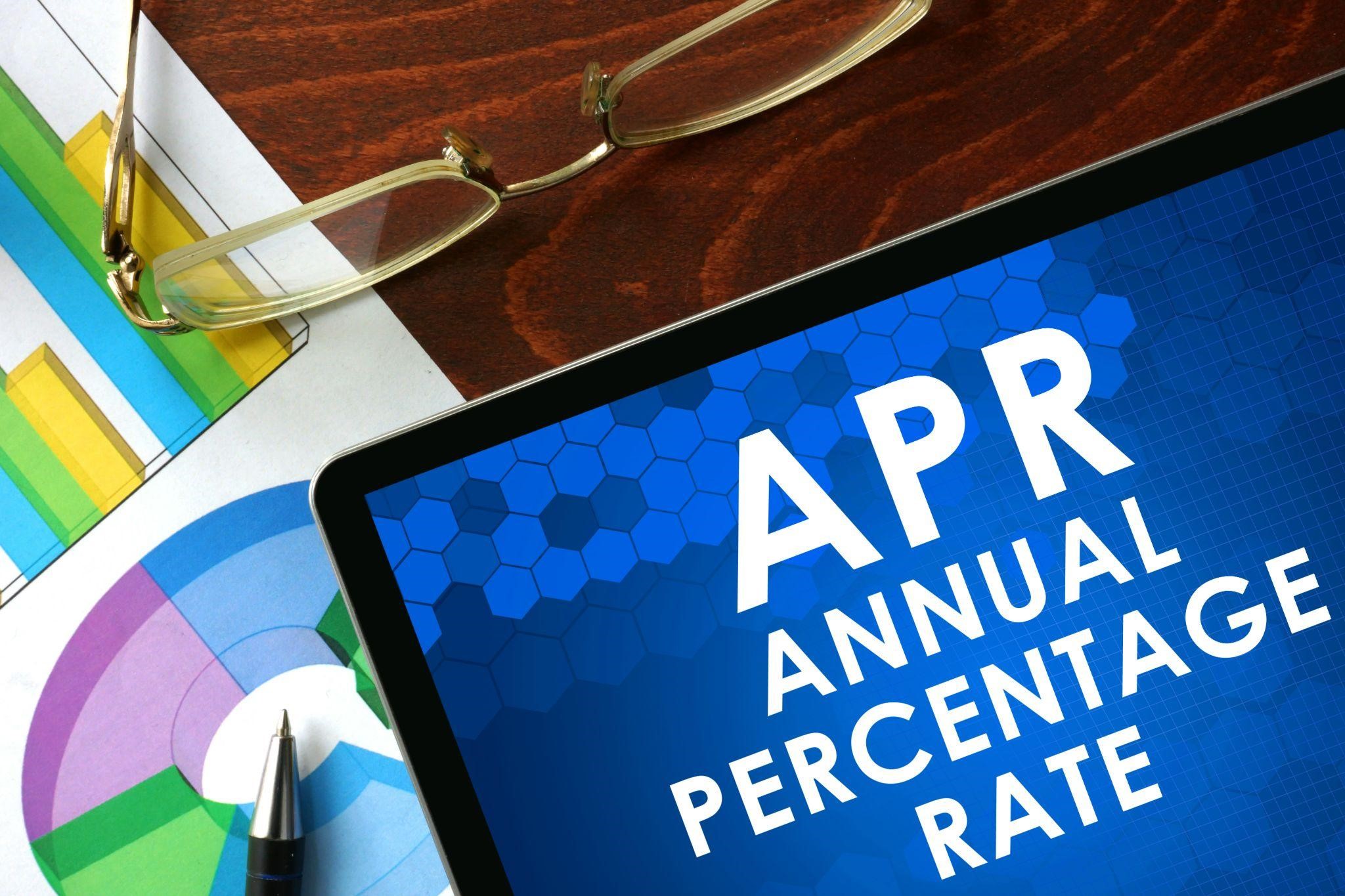What is Annual Percentage Rate – Its Formula, Working And How is It Calculated

The Annual Percentage Rate (APR) is the initial expense or benefit of a loaned or borrowed sum of money. The APR provides lenders and borrowers with a quick glimpse of how much interest they are earning or paying over a specific period of time by calculating only the simple interest without periodic compounding.
For the majority of us, selecting the best loan involves going with the lender with the lowest interest rates. However, this procedure is incorrect and can eventually ruin your cash.
So, knowing the cost of borrowing ahead is made possible using a standardised calculation process, such as the annual percentage rate.
What is Annual Percentage Rate (APR)?
The annual interest produced by a sum that is paid to investors or charged from borrowers is referred to as the annual percentage rate (APR).
APR is a percentage that expresses the actual annual cost of borrowing money through a loan or the revenue from an investment. This does not account for compounding or include any fees or additional expenditures related to the transaction.
Consumers can evaluate lenders, credit cards, and investment goods using the APR as a benchmark figure.
How Does APR Work?
An interest rate is written as an annual percentage rate. It factors in variables like monthly payments to determine what proportion of the principal you will pay annually. APR is another term for the yearly interest rate paid on investments that do not consider the annual compounding of interest.
Lenders are required to provide borrowers with the APR they charge as per the Truth in Lending Act (TILA) of 1968. Credit card firms permit monthly interest rate advertising, but clients must be made aware of the APR prior to signing an agreement.
How is APR Calculated?
The annual percentage rate (APR) is calculated by multiplying the interest rate (periodic) by the frequency of periods in the year.
APR = (((Fees+Interest)/Principal)/n) x 365) x 100
Where,
- Interest = Entire interest amount paid over the loan tenure,
- Principal = The borrowed amount,
- N = The loan tenure
Also Read
Types of APR
Depending on the type of charge, credit card APRs change. The credit card company may have different APRs for purchases, cash advances, and balance transfers from other cards. Customers who make late payments or violate other provisions of the cardholder agreement are subject to high-rate penalty APRs from issuers.
- Purchase APR: The interest rate is charged on all purchases made with your card, whether done in-person, online, or over the phone.
- Introductory APR: A temporary, introductory interest rate that is lower than the card’s regular APR and occasionally even zero per cent APR. Purchases, balance transfers, or both may be covered. Your balance will be subject to the standard APR following the end of the introductory period.
- Cash Advance APR: This is often higher than the purchase rate and does not include a grace period. Convenience checks frequently use it as well.
- Penalty APR: It is charged as high as 29.99 per cent for late or returned payments. Before your credit card company removes the penalty APR, you might need to make multiple consecutive on-time payments. Your existing balance can also be subject to the penalty APR if payments are more than 60 days past due.
Fixed APR vs. Variable APR
The primary difference between fixed APR and variable APR is that fixed APR does not change with the index. Whereas a variable APR, as its name suggests, fluctuates with the respective indexed interest rate.
The fixed APR depends on the market conditions when you take a loan. Afterward, they remain constant throughout your loan tenure and do not fluctuate. However, variable APR fluctuates with changing index rates.
Such an APR increases when index rates increase due to changes in market conditions.
What is a Good APR?
What constitutes a “good” APR will vary depending on the market’s competitive rates, the central bank’s prime interest rate, and the borrower’s credit rating.
Companies in competitive industries occasionally offer extremely low APRs on their credit products, such as 0% on vehicle loans or leasing options, when prime rates are low. Customers should confirm whether these cheap rates are permanent or just introductory rates that will change to a higher APR after a set amount of time has passed, even though these low rates could sound alluring. Furthermore, individuals with particularly excellent credit ratings can be the only ones who can get cheap APRs.
Why Should You Know the Annual Percentage Rate?
The APR’s main goal is to make it easier for you to compare different loan options because it amplifies the genuine cost of a loan. However, it is crucial to remember that APR does not take compounding into account and is useless for loans with fluctuating interest rates.
Having said that, comparing loans is facilitated by knowing the APR. You are better positioned to analyse the cost of these perks if the annual percentage rate (APR) on a loan with superior benefits is slightly higher than the advertised annual percentage rate.
Why is the Annual Percentage Rate Disclosed?
In order to prevent businesses from deceiving clients, consumer protection regulations compel firms to publish the APRs linked to their product offerings. A business might, for instance, promote a low monthly interest rate while giving the impression to customers that it was an annual rate if they were not compelled to reveal the APR. This can mislead a buyer into contrasting an apparent high annual charge with an apparent cheap monthly rate. Buyers are confronted with a “apples to apples” comparison by requiring all companies to reveal their APRs.
Final Word
The APR can be deceiving if someone is borrowing money, such as when they use a credit card or apply for a mortgage, because it merely displays the base amount of what they would pay without accounting for time. The APR on a savings account, on the other hand, does not fully convey the impact of interest accrued over time.
Also note that different financial institutions will add different fees to the main balance, even if the formula for your APR might not change. When concluding any deal, be mindful of what your APR covers!
FAQs
Ans: Input the loan amount, the rate of interest, and the tenure. Now fill in the additional fee amount, i.e., your loan processing fee or any other charges applicable on your loan. The APR will appear on the right side of the calculator.
Ans: Despite its flaws, APR is a useful tool for assisting prospective loan applicants in determining the actual cost of borrowing. Lenders frequently just advertise the interest rate and withhold information about the overall cost. Fees and extra costs are broken down into individual line items in the list. When applying for a home loan or a loan against property, APR is a beneficial calculating tool. The rate, processing fee, and other costs make up a significant portion of the total cost for long-term payback terms of typically 20 years or more.
Ans: The annual percentage cost of borrowing money is the interest rate on an auto loan. Fees associated with the loan are not included in the interest rate. However, the cost of borrowing money annually, including fees, is stated as a percentage and is known as the annual percentage rate (APR).
Ans: To raise your credit score, pay your bills and EMIs on time, cut back on your frivolous spending, and adopt better spending practices. You can bargain with the bank to acquire a better APR on the loan if you have a good credit score, which will reflect favourably on you.
Personal Loan in Your City

Customer’s Feedback
No comments found.10 Best Bank for Savings Account in India [Highest Interest Rate 2023]
Savings account is a type of financial instrument offered by several banks. It lets you safely depo... Read More »What is Issuer Identification Number (IIN)- Working and Importance
What is an Issuer Identification Number (IIN)? Banks and financial institutions assign a distinc... Read More »What is a Vostro Account – Meaning, Working and Difference
What is a Vostro Account? A Vostro account is a bank account held by a domestic bank on behalf o... Read More »What is a Solvency Certificate? – Format, Documents Required & How to Apply Online?
What is a Solvency Certificate? A solvency certificate is a legal document furnishing the detail... Read More »What is Merchant Banking – Services, Features, Functions and Example
What is Merchant Banking? Merchant banking is a set of select banking and financial services off... Read More »Automated Clearing House: Objectives, Types and Process
Automated Clearing House is an electronic fund transfer network that manages automatic and direct... Read More »How to Redeem Credit Card Reward Points ?
Credit Card Reward points are types of incentives that customers receive when they use a credit car... Read More »What is Electronic Clearing Service (ECS) in Banking and How does it Work?
What is Electronic Clearing Service (ECS)? Electronic Clearing Service (ECS) is a method of elec... Read More »What are Credit Card Validators and How to Use them?
What is a Credit Card Validator? A credit card validator is a tool that checks the validity of a... Read More »What is Cash Management and How Does it Work?
Managing available capital can make sure that a small business stays afloat. Cash management is an ... Read More »What are Prepaid Expenses? – Definition, Examples, and Journal Entry
Prepaid expenses represent payments made in advance for products or services expected to be incurre... Read More »Increase Credit Card Limit – Important Tips and How to Do It?
The credit card limit is the maximum amount of money you can spend using your credit card. Your cre... Read More »Top 10 Chit Fund Schemes in India in 2023
Chit funds are one of the most popular return-generating saving schemes in India. It is a financial... Read More »10 Best Gold ETFs in India to Invest in April 2023
Gold ETFs or Gold Exchange Traded Funds are passively managed funds that track the price of physica... Read More »10 Best Demat Accounts in India for Beginners in 2023
Creation of Demat accounts revolutionised the way trades were conducted at the stock exchanges. It... Read More »20 Best Index Funds to Invest in India in April 2023
What is an Index Fund? An index fund is a type of mutual fund or exchange-traded fund (ETF) that... Read More »Best Arbitrage Mutual Funds to Invest in India in April 2023
Arbitrage funds are hybrid mutual fund schemes that aim to make low-risk profits by buying and sell... Read More »10 Best SIP Plans in India to Invest in April 2023
What is SIP? SIP or Systematic Investment Plan is a method of investing a fixed amount in ... Read More »10 Best Corporate Bond Funds in India to Invest in April 2023
Corporate bond funds are debt funds that invest at least 80% of the investment corpus in companies ... Read More »10 Best Bank for Savings Account in India [Highest Interest Rate 2023]
Savings account is a type of financial instrument offered by several banks. It lets you safely depo... Read More »





















